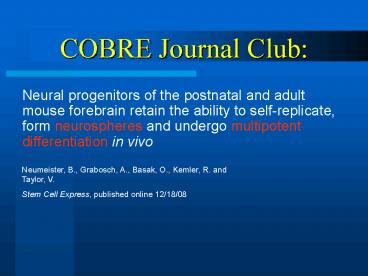COBRE Journal Club: - PowerPoint PPT Presentation
1 / 35
Title: COBRE Journal Club:
1
COBRE Journal Club
- Neural progenitors of the postnatal and adult
mouse forebrain retain the ability to
self-replicate, form neurospheres and undergo
multipotent differentiation in vivo
Neumeister, B., Grabosch, A., Basak, O., Kemler,
R. and Taylor, V. Stem Cell Express, published
online 12/18/08
2
Neural stem cell differentiation
3
(No Transcript)
4
from Marci et al., J. Neurosci. 23(1)2003
5
from Goldman, S., Nature Biotech. 232005
6
from Rao et al., Anat. Rec. 2571999
7
(No Transcript)
8
(No Transcript)
9
(No Transcript)
10
(No Transcript)
11
(No Transcript)
12
(No Transcript)
13
(No Transcript)
14
(No Transcript)
15
Do postnatal and adult EGF-dependent neurospheres
retain their primary stem cell feature to
self-replicate following long-term engraftment?
Experiment 1
16
Figure 1A Schematic diagram of experimental
procedure
- isolated and expanded neurospheres from postnatal
and adult mice that ubiquitously express
bacterial ß-galactosidase or Renilla GFP
(markers). - using ultrasound backscatter microscopy,
transplanted neurosphere-derived cells into
forebrains of mice at mid-embryogenesis.
17
Figure 1 Transplanted NSCs associate with the
host brain.
E 3 hours post transplantation.
F 24 hours post transplantation.
G 72 hours post transplantation.
18
Can EGF-dependent neurospheres survive in the
host brain and differentiate?
Experiment 2
19
Figure 2 Transplant-derived cells generate glia.
20
Figure 3 Transplant- derived cells
generate neurons.
21
Can transplanted cells retain the ability to
self-renew and generate neurospheresin vitro?
Experiment 3
22
Figure 4 Re-transplantation of NSC showing
neurosphere self-renewal.
23
Can transplant-derived neurospheres retain
neurospherogenic potential over multiple rounds
of transplantation?
Experiment 4
24
Figure 4 Re-transplantation of NSC showing
neurosphere self-renewal.
25
Figure 5 Re-transplanted NSCs generate
neurospheres that are multipotent.
26
Are neurosphere-forming transplanted cells
mitotically active in vivo?
Experiment 5
27
Figure 6 Transplanted NSCs proliferate in the
host brain.
E Most NSCs from primary hosts were generated
from BrdU cells.
F Most of the host-derived (GFP-) and
transplant-derived (GFP) neurospheres contain
BrdU label.
G Quantification of BrdU label-containing
neurospheres.
28
Do mitotically active neurosphere forming
transplanted cells integrate into the neurogenic
brain regions of the host?
Experiment 6
29
Figure 7 Transplanted NSCs proliferate in the
host brain.
Confocal image showing transplanted cells (GFP)
integrated into the subventricular zone (SVZ) of
the host brain.
30
The End
31
(No Transcript)
32
(No Transcript)
33
Figure X
34
Figure X
35
Neurosphere formation

